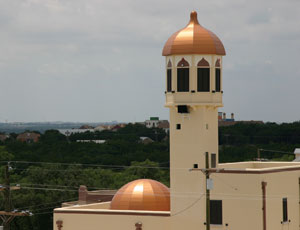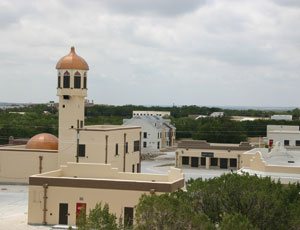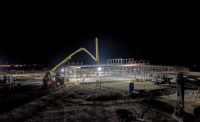Escalation of the war in Afghanistan and nuclear proliferation in Iran underscore the need for new Army training facilities such as the $17.6-million Combined Arms Collective Training Facility completed in April at Fort Hood, the U.S. Army’s training post in the Central Texas city of Killeen.


“Not too many other places have this type of urban training facility, which is a replica of a Middle East village,” says Samuel Parker, area engineer for the Central Texas area office of the U.S. Army Corps of Engineers, which managed construction. “It has 28 different mock buildings – including a service station, clinic, radio station, hotel, strip mall, bank, apartment complex, school, mosque, residences, city hall and police station. It looks like something you would find in Iraq or Saudi Arabia.”
The 45-acre site seems minor in comparison to the 340-sq-mi footprint of Fort Hood, but the CACTF plays in integral role in the fort’s mobilization mission. “There are 58,000 soldiers at Fort Hood who have been deployed to the Middle East over the past seven or eight years,” Parker says. He adds that outside units may also be brought in for training cycles.
The buildings are actually hollow shells, with some interior details such as stairwells that allow soldiers to practice the training required to simulate “real-life” circumstances, Parker says.
The facility has internal and external video cameras for training purposes, a speaker system and some automated targets, says Reynaldo Navarro Jr., range planner at Fort Hood. “The facility was constructed for military units up to company size,” Navarro says. It is not a live-fire facility, which means the structures aren’t built to ballistics- or explosive-resistant standards, he adds.
The Fort Hood CACTF is one of several Middle East replica facilities used by the Army for training, but it is the onlyone that features an embassy building, Navarro says.
Additionally, roads throughout the “village” are built to withstand heavy traffic such as tanks, Parker says. “Most of the roads are gravel, except right in “town,” where we installed 8- to 10-in. concrete paving in the radiuses where vehicles turn,” says Bobby Jones, federal team leader for the general contractor, Emerson Construction of Temple. “We also built one bridge that crosses a creek.”
Using all reinforced concrete, it was built to Texas Dept. of Transportation specifications.
In addition to the 28 replica buildings, Emerson constructed four classrooms and installed all infrastructure, including wiring for surveillance equipment, water and roads. Although Emerson has built several training ranges at Fort Hood, the CACTF was unique for the contractor. “We’ve built a lot of ranges there for all kind of infantry training, tank firing and digital, multipurpose ranges,” Jones says. “But this was our first one like this.”
Emerson has been involved in a lot of military work at Fort Sam Houston and Lackland Air Force Base, both in San Antonio, as well as projects in the Fort Worth area, Jones says. “Currently, probably 65% to 70% of our work is public,” he adds
The Fort Hood CACTF buildings are slab-on-grade foundations, steel- and concrete-enforced concrete masonry units and concrete roofs. “Having the concrete roofs so they can land helicopters on them was unique,” Jones says. Other features include rooftop anchors for rappelling training.
Emerson installed some 60-in. pipe to create underground tunnels as well for training. It also had some...



Post a comment to this article
Report Abusive Comment